
Features
Growing Media
Inputs
Special Series: growing in the rootzone #13
March 20, 2013 By Andrew Lee
Working with less drain per cent allows you to steer the crop with fewer inputs of water, fertilizer and energy.
From the beginning of growing in substrate, achieving 30 per cent drain over 24 hours was always a good checkpoint for growers to know that they had supplied enough water for the plants.
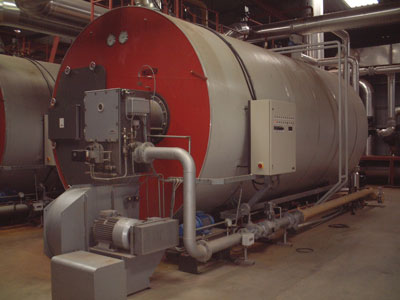 |
|
| Working with less drain can save energy. Advertisement
|
Drain was and still is necessary to compensate for unevenness in the irrigation system, greenhouse climate and plant activity.
However, the incorporation of hanging gutters and improvements in irrigation and climate control have significantly improved uniformity within the greenhouse and thus the way the plants react.
The introduction of Next Generation Substrates of Grodan, which also exhibit greater uniformity in WC and EC, now provide opportunities to grow the crop with less drain over 24 hours.
LESS DRAIN WILL SAVE WATER AND FERTILIZER
Working with less drain will save water and fertilizer, factors that will ultimately reduce emissions to the environment.
However, working with less drain can also save energy, especially in the morning around sunrise and on overcast/humid days. If the plants are irrigated at the wrong time or too often on these days, water will be consumed by the plant passively because of osmotic differences between the root cells (higher osmotic potential) and surrounding rootzone (lower osmotic potential). This produces a strong vegetative reaction.
To avoid having plants become too vegetative, more energy has to be used, i.e., setting a higher minimum pipe temperature. This means extra energy costs (Table 1). With the click of a mouse or the press of a button it is easy to increase the minimum pipe temperature but there is nothing to say “be aware this will cost you lots of money.”
To convert these values into the actual cost of energy per hectare, take the appropriate figure from the table, i.e., an increase in pipe temperature of 10 C for six hours equals 2,250 kWh of extra fuel. Then simply multiply this by the cost of fuel. (At the time of writing, the price in the U.K. is 2.4 pence per kWh. So in this example, the additional cost would be £54 ($84 Cdn) per hectare per six-hour event.)
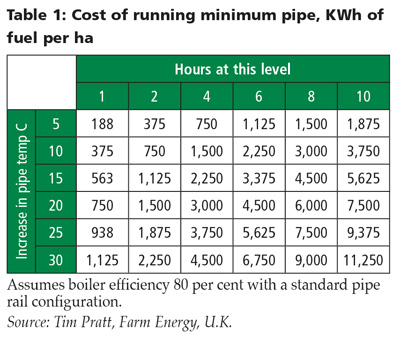 |
KEEPING PLANTS IN BALANCE BY ADJUSTING THE WATERING
The plant can be kept in balance and energy can be saved by starting irrigation when the plant becomes active; you can see when this happens using the WCM-c as the rate of slope on the WC line changes (becomes steeper, i.e., >1 per cent per hour) shortly after sunrise.
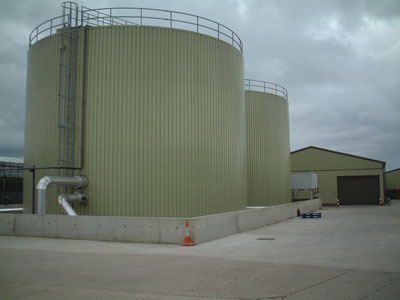 |
|
| Working with less drain per cent provides opportunities to steer the crop with fewer inputs of water, fertilizer and energy.
|
Another benefit of working with a limited drain volume will be greater stability in feed solution, particularly the K:Ca balance when recycling, again resulting in less emission and compliance with environmental legislation.
Irrigation gives a vegetative stimulus to the plant because the EC surrounding the roots decreases and the WC increases. Therefore, during dark days when the goal is to steer the plant generative, irrigation should be minimal, especially in the morning (late start) and afternoon (frequency and early finish).
If on these days we have a target drain per cent in mind, it is very easy to provide too much water. This will make the crop too vegetative and will also weaken the root system. On these days it is more desirable to achieve a minimal drain volume (Tables 2 and 3). Making drain should not be a goal, but only a result of a structured irrigation strategy.
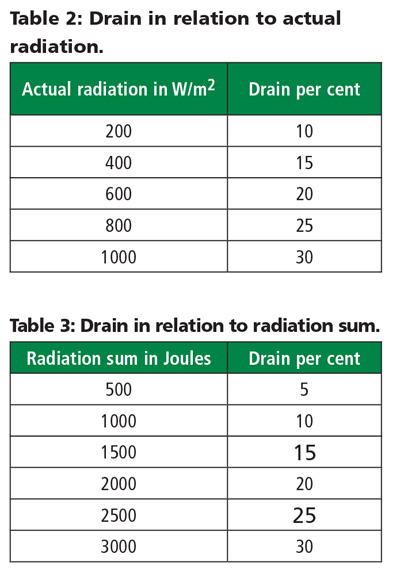 |
DRAIN PER CENT FOR STABILIZING EC IN THE ROOTZONE
n It’s important that substrates are uniform in WC and EC. This is especially important when working with a low WC or high EC for generative crop steering in line with energy management.
However, another benefit of a uniform substrate is that day level targets for substrate EC can be attained with lower drain volumes. If the EC values in the slabs are within the recommended range (refer to 6 phase reference tables), Grodan’s advice would be to achieve 15-20 per cent of drain per irrigation cycle, remembering that during dark days irrigation is required to compensate for only the water uptake of the crop.
DRAIN PER CENT FOR DECREASING EC IN THE ROOTZONE
Decreasing EC is best achieved by reaching drain in the first three to four irrigation cycles in the morning (Figure 1).
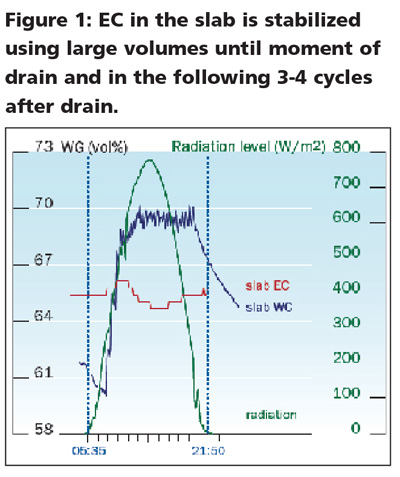 |
When a decrease in day level EC is desired, the irrigation cycles in the morning prior and immediately following first drain need to be large (4-6 per cent of the substrate volume per square metre). A high drain per cent (40-80 per cent) in the cycles following the first is perfect for optimum EC reduction.
With this in mind, the moment of first drain also needs to be timed correctly and should be achieved before maximum transpiration, i.e., before 600 W/m2 or 400 J/cm2. If the EC in the slab is within optimum range (refer to 6 phase reference tables) the amount of drain during the afternoon period can be limited to 20-25 per cent in line with radiation (W/m2 and radiation sum (J/cm2) (Tables 2 and 3).
Figure 1: EC in the slab is stabilized using large volumes until moment of drain and in the following 3-4 cycles after drain.
The WCM-handheld unit is a perfect tool to determine the uniformity between individual slabs. Use the “multi-measurements” function to provide “statistics” for each irrigation valve; this will give you an indication of the variation in WC and EC. This will also help you further optimize the drain per cent (Table 4).
 |
If the standard deviation in WC and EC is too small, perhaps the amount of water given and also the drain per cent is too high? On the other hand, if the standard deviation is too large, there could be problems with the drippers or drain holes, or mistakes are being made in irrigation strategy.
CONCLUSION
Targeting drain is no longer a goal but a result. Working with less drain per cent provides you with opportunities to steer the crop with fewer inputs of water, fertilizer and energy.
Knowing what is happening in the substrate gives you possibilities to optimize the overall growth and vegetative–generative development of the plants to maintain them in perfect balance. Significant improvements to the irrigation strategy can be made in the morning and especially on darker days.
Using the information of Grodan WCM-continuous and WCM-handheld monitoring provides the necessary management information to enable “Precision Growing.”
Print this page